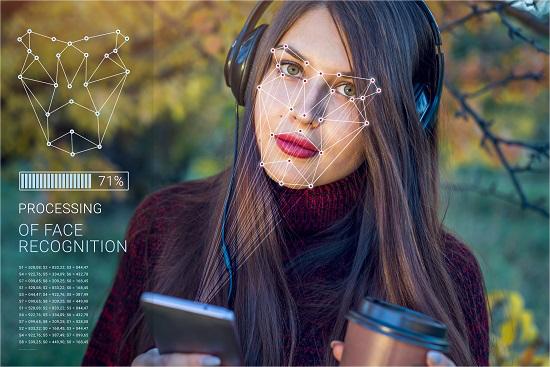Biometrics are body measurements and calculations related to human characteristics. Biometric authentication (or realistic authentication) is used in computer science as a form of identification and access control. It is also used to identify individuals in groups that are under surveillance.
Biometric identifiers are the distinctive, measurable characteristics used to label and describe individuals. Biometric identifiers are often categorized as physiological characteristics which are related to the shape of the body. Examples include, but are not limited to fingerprint, palm veins, face recognition, DNA, palm print, hand geometry, iris recognition, retina, and odor/scent.
Biometric identification technology involves computer science, optics and acoustics and other physical sciences, biological sciences, biosensors and biostatistics principles, security technology, and artificial intelligence technology and many other basic sciences and innovative application technologies. It is a complete multidisciplinary technical solutions.
In recent years, with the development of artificial intelligence, biometric identification technology has become more mature. At present, face recognition technology is the most representative of biometrics.
Face recognition
The process of face recognition includes face collection, face detection, face feature extraction and face matching recognition. The face recognition process uses various technologies such as AdaBoos algorithm, convolutional neural network and support vector machine in machine learning.
The process of face recognition
At present, the traditional face recognition difficulties including face rotation, occlusion, similarity, etc. have been greatly improved, which greatly improves the accuracy of face recognition. 2D face, 3D face, multi-spectral face Each mode has different acquisition adaptation scenarios, data security degree and privacy sensitivity, etc., and the addition of deep learning of big data makes the 3D face recognition algorithm supplement the defects of 2D projection, It can quickly identify the identity of a person, which has brought a certain breakthrough for the application of two-dimensional face recognition.
At the same time, the biometric detection technology is currently being used as a key technology to improve the security of face recognition, which can effectively resist counterfeiting fraud such as photos, videos, 3D models, and prosthetic masks, and independently determine the identity of operating users. At present, with the rapid development of face recognition technology, many innovative applications such as smart devices, online finance, and face payment have become increasingly popular, bringing speed and convenience to everyone’s life and work.
Palmprint recognition
Palmprint recognition is a new type of biometric recognition technology, which uses the palmprint of the human body as the target feature, and collects biological information through multispectral imaging technology. Multi-spectral palmprint recognition can be regarded as a model of biometric recognition technology that combines multi-modality and multiple target features. This new technology combines the three identifiable features of skin spectrum, palm print and vein veins to provide more abundant information at one time and increase the distinguishability of target features.
This year, Amazon’s palm recognition technology, code-named Orville, has begun testing. The scanner first acquires a set of infrared polarized original images, focusing on the external features of the palm, such as lines and folds; when acquiring the second set of polarized images again, it focuses on the palm structure and internal features, such as veins, bones, soft tissues, etc. The raw images are initially processed to provide a set of images containing hands. These images are well-lit, in focus, and show the palm in a specific orientation, in a specific pose, and labeled as left or right handed.
At present, Amazon’s palmprint recognition technology can verify personal identity and complete payment in only 300 milliseconds, and does not require users to put their hands on the scanning device, just wave and scan without contact. The failure rate of this technology is about 0.0001%. At the same time, the palmprint recognition is a double verification in the initial stage – the first time to obtain external characteristics, and the second time to obtain internal organizational characteristics. Compared with other biometric technologies in terms of security, improved.
In addition to the above biometric features, iris recognition technology is also being popularized. The false recognition rate of iris recognition is as low as 1/1000000. It mainly uses the characteristics of iris life invariance and difference to identify identities.
At present, the consensus in the industry is that the recognition of a single modality has bottlenecks in both recognition performance and security, and multi-modal fusion is an important breakthrough in face recognition and even biometric recognition—not only through multi-factor The way to improve the recognition accuracy can also improve the scene adaptability and privacy security of biometric technology to a certain extent. Compared with the traditional single-mode algorithm, it can better meet the financial-level false recognition rate (as low as one in ten million), which is also the main trend of the development of biometric identification.
Multimodal biometric system
Multimodal biometric systems use multiple sensors or biometrics to overcome the limitations of unimodal biometric systems.For instance iris recognition systems can be compromised by aging irises and electronic fingerprint recognition can be worsened by worn-out or cut fingerprints. While unimodal biometric systems are limited by the integrity of their identifier, it is unlikely that several unimodal systems will suffer from identical limitations. Multimodal biometric systems can obtain sets of information from the same marker (i.e., multiple images of an iris, or scans of the same finger) or information from different biometrics (requiring fingerprint scans and, using voice recognition, a spoken passcode).
Multimodal biometric systems can fuse these unimodal systems sequentially, simultaneously, a combination thereof, or in series, which refer to sequential, parallel, hierarchical and serial integration modes, respectively.
CHANCCTV has developed a series of biometric lenses for face recognition, palmprint recognition as well as fingerprint identification and iris identification.For instance CH3659A is a 4k low distortion lens which was designed for 1/1.8’’ sensors. It features all glass and compact designs with mere 11.95mm TTL. It captures 44 degrees horizontal field of view. This lens is ideal for palmprint recognition.
Post time: Nov-23-2022




